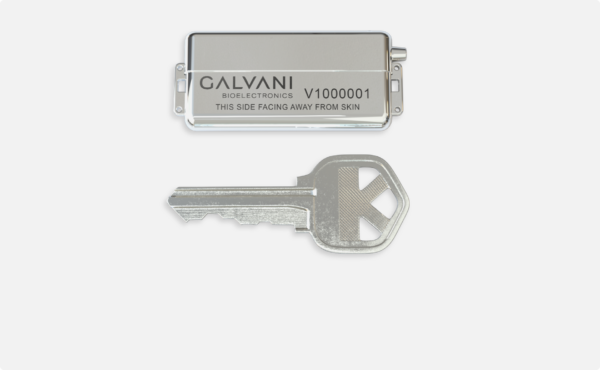
Galvani Bioelectronics’ neurostimulator system
GSK and Verily joint venture Galvani Bioelectronics laparoscopically implanted a neurostimulator in a rheumatoid arthritis (RA) patient as part of the NHS Greater Glasgow & Clyde Health Board’s clinical study in Scotland. This first patient implantation marks a major milestone for Galvani’s RA neuromodulation therapy, the company said. Galvani’s laparoscopical neurostimulator is an experimental therapy that that uses splenic nerve stimulation for RA patients to reprogram the spleen’s immune cells to an anti-inflamation state, which mitigates patients’ pain and inflammation.

With the Rise of AI, What IP Disputes in Healthcare Are Likely to Emerge?
Munck Wilson Mandala Partner Greg Howison shared his perspective on some of the legal ramifications around AI, IP, connected devices and the data they generate, in response to emailed questions.
The neurostimulator is intended as a minimally invasive outpatient treatment. Once laparoscopically implanted, the treating physician can program the neurostimulator through a wirelessly connected tablet. Additionally, patients control and monitor their own therapy through a smartphone. They can also charge their implant wirelessly.

The Galvani neurostimulator implant is roughly the size of house keys
The treatment works by using splenic nerve stimulation to send nerve signals to the spleen. Doing so prompts splenic immune cells to adjust to inflammation-resolving states instead of pro-inflammation states. The anti-inflammation cells then migrate to injury sites, such as joints in RA, and can potentially reduce the pain and inflammation in the area, as well as possibly resolve it.
The company’s CEO described the treatment as “the first in a new class of potential therapies” that selectively stimulate nerves that are directly associated with individual visceral organs that are central to a specific disease. The signals generated in these nerves control functions of the organs and aim to shift from disease to healthy states.
“This constitutes a new, different means to address disease. Such a new treatment class is challenging to establish, as it requires the development of a new device system and surgical techniques in addition to the specific treatment parameters, something that Galvani has spent 5 years of extensive research and development to develop,” said Kristoffer Famm, president of Galvani in an email.
Famm explained that the spleen has been the “ultimate target organ” for indirect neuromodulation approaches. That includes experimental devices in clinical development such as implanted cervical vagus nerve stimulation as well as non-implanted devices that seek to stimulate the organ across the skin and tissue.
He believes that “stimulating the nerve directly and only linked to the spleen” is expected to have larger benefits and fewer limitations and side effects tied to other more established therapies that stimulate the vagus nerve. Famm also contended that Galavani’s approach of stimulating splenic nerves is superior to other indirect methods of stimulating the spleen.
“For the splenic nerve, extensive preclinical evidence has demonstrated that electrical stimulation generates nerve signals to the spleen leading to the release of so called neurotransmitters that affect passing immune cells and shift them from an inflammation-driving to an inflammation- resolving state,” Famm explained. “As the blood, full of immune cells, filters through the spleen during its constant circulation, the reprogrammed cells then flow to the sites of injury in disease, for example the joints, leading to potential reduction or resolution of the inflammation there.“
The hope is to restore the spleen to a healthier functioning state. In doing so, the therapy expects to potentially minimize — or even mitigate — the symptoms of an array of autoimmune diseases.
Rheumatoid arthritis is a form of arthritis that causes pain, swelling, stiffness and loss of function in joints and is incurable. It is estimated to affect more than 1.3 million Americans. The burden of the disease is prompting companies to adopt different approaches including a precision medicine approach.
Galvani Bioelectronics has also initiated a parallel clinical trail in the U.S. with locations in New York, Oregon, Dallas, and Austin. The U.S.-based studies will investigate the efficacy of Galvani’s platform in the same population of RA patients as well as its safety.
The company hopes the splenic nerve stimulation treatment will prove not only a viable option for RA patients who do not respond to current treatments, but it also anticipates the immunomodulation will offer potential treatment avenues for other auto-immune conditions, too.
Aside from the spleen, Galvani is targeting other organ-specific autonomic nerves — nerves which regulate functions of internal organs — such as the, lymph nodes, liver, kidneys, and lungs.
“Broad research evidence from animal models of chronic diseases suggest dialing up or down the signaling going down these nerves can help the body restore healthy organ functions or correct itself in diseases where a different level of these functions are needed,” Famm said.
Rheumatoid arthritis is a form of arthritis that causes pain, swelling, stiffness and loss of function in joints and is incurable. It is estimated to affect more than 1.3 million Americans. The burden of the disease is prompting companies to adopt different approaches including a precision medicine approach.
Photo: Galvani Bioelectronics














